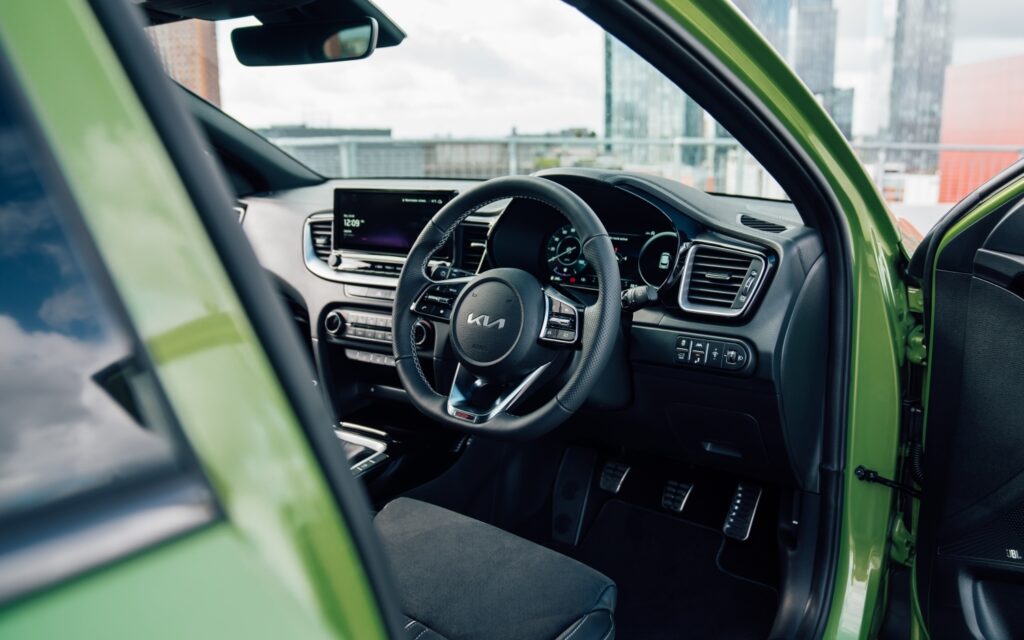The SUV crossover XCeed has proven to be a popular car for Kia, outselling its other variants, the Ceed hatchback, Ceed Sportswagon and ProCeed shooting brake.
We shouldn’t be surprised, as that follows a trend that’s increasingly seeing SUVs and crossovers becoming families’ go-to cars of choice.
The XCeed looks like a taller Ceed hatchback with some off-road cladding added around its outer extremities. But it’s now had a mid-life facelift, which adds some LED lights, a new grille and a slightly revised front end.
The XCeed trim levels have also been revised and simplified, with one petrol non-hybrid and one plug-in hybrid model.
For the petrol model, the entry-level ‘2’ trim includes 16-inch wheels, an eight-inch infotainment screen, Apple CarPlay/Android Auto, and a leather steering wheel. It also sports a faux leather gear lever, electric windows, cruise control and a reversing camera.
The mid-range ‘3’ grade gets 18-inch alloys, a 10.25-inch infotainment screen, SatNav, heated steering wheel and front seats, rain-sensing wipers, keyless entry/go and an electronic parking brake.

The top GT-Line S adds a 12.3-inch digital instrument cluster, JBL premium sound system, panoramic sunroof, and sports seats. It also boasts black leather, suede upholstery, and some athletic interior and exterior styling.
The PHEV only offers the ‘3’ trim, like the ‘3’ provided in the petrol. However, it gets 16-inch alloys for better ride comfort, given its stiffer suspension.
Whereas the petrol version gets a 160PS 1.5-litre turbocharged engine and a six-speed manual, the PHEV gets a 141PS 1.6-litre unit and electric motor, with a six-speed automatic.
It is unusual to find a plug-in version that generates less power than the non-hybrid. But that’s the case here, with the petrol car reaching 60mph in 8.7-seconds, compared with 10.6-seconds in the PHEV.
Both versions feel slightly restrained if you’re in a hurry, with the power feeling a touch strangled at lower revs.
The petrol’s superior performance is helped by the slick manual gearbox, whereas the PHEV’s automatic feels slightly sluggish to respond.

Ride comfort in both versions is reasonable, although the XCeed tends to crash through potholes. That is especially the case in the petrol due to the larger alloys on the GT-Line S, compared with the smaller wheels on the PHEV.
It is never uncomfortable, though. And the PHEV’s wheels help to offset the effects of its suspension setup, which is firmer to cope with its extra weight.
Whether driving slowly around town or doing the national speed limit on a dual-carriageway or motorway, the Kia XCeed feels stable and well-planted.
Both versions handle reasonably well in the corners. Nevertheless, as you’d imagine, there’s more body roll compared with the standard Ceed due to a higher centre of gravity. Also, the PHEV’s extra weight means it’s not as agile as the petrol.
While most folk won’t be testing the XCeed’s limits in the bends, there’s little sense you’re about to run out of grip.
Inside the cabin, you’ll think the XCeed looks fantastic – until you see the interiors in Kia’s other SUVs, the Niro and Sportage. Both have had futuristic overhauls, which look the part, and although there’s nothing wrong with the XCeed’s, it isn’t entirely on the same level.

Nevertheless, there are plenty of squidgy-to-the-touch materials, silver garnish on the steering wheel, dashboard and around the gear lever.
The infotainment system, which angles slightly towards the driver for a better view, is excellent. It features nicely designed graphics, easy-to-navigate menus, and a high-resolution screen. There are also three USB ports, two of which are the newer USB-C style.
The standard seats are comfy, although the petrol model’s top-of-the-range GT-Line S gets sports seats. These are even better, but this trim also comes with a panoramic sunroof which, while very nice, limits headroom in the rear seats.
This is worth considering if you will regularly transport adults in the back seats. Why? Well, the Kia’s headroom is already compromised by the sloping roofline, while rivals generally offer a bit more rear legroom.
The front of the cabin has no such worries, though, while the boot gets a decent 426 litres of space. This capacity increases to 1,378 litres with the rear seats folded in a 40:20:40 split, although the PHEV’s figures are 291 litres expanding to 1,243 litres.
The boot floor is adjustable, which is brilliant as you may be happy to sacrifice a bit of space to minimise the fairly large load lip.

In terms of running costs, you’ll get 44.8mpg out of the petrol (slightly more on the entry-level trim), producing 143g/km of CO2 in the process. This is versus 201.7mpg in the PHEV, which reduces CO2 emissions to just 32g/km.
Keeping the PHEV’s 8.9kWh battery charged is crucial if you want to get near those figures, though. It takes just over two hours to fully charge from empty at a rate of 3.3kW and will allow up to 30 miles of all-electric range.
Although the XCeed’s low emissions will save you money in Benefit in Kind tax if you’re a company car driver, some competitors can offer even greater savings.
But whether you go for the petrol or PHEV, you’ll get Kia’s outstanding reputation for reliability, backed up by a seven-year warranty limited to the first 100,000 miles.
On the safety side, the Kia XCeed uses the standard Ceed rating from Euro NCAP, which was four stars when the hatchback was crash-tested in 2019. It scored 88 per cent for adult occupants, 85 per cent for children and 68 per cent for safety assists.
Safety technology includes cruise control with a speed limiter and forward collision avoidance assist. But only the petrol GT-Line S gets a blind-spot collision warning and intelligent speed limit alert.

So, dads, when all is said and done, the latest Kia XCeed is a good all-rounder with a lot to offer.









Leave a Comment
You must be logged in to post a comment.